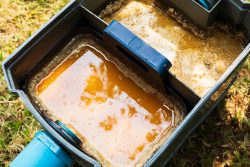Complete Guide to Commercial Grease Trap Cleaning

Importance of Grease Trap Maintenance
Grease trap maintenance is crucial for both regulatory compliance and kitchen hygiene. Neglecting grease trap cleaning can lead to a build-up of FOG, which can result in blockages in drains, foul odors, and the potential for sewage backups. This can not only disrupt operations but also pose a health hazard to both employees and customers. Additionally, failure to comply with local regulations regarding grease trap maintenance can result in fines and penalties, which can be financially burdensome for any commercial establishment.
Cleaning Process
Step 1: Preparation
Before starting the cleaning process, it is important to turn off all equipment connected to the grease trap to prevent any accidental flow of wastewater. It is also advisable to wear protective clothing, gloves, and goggles to ensure safety.
Step 2: Remove the Lid
Carefully remove the lid of the grease trap using appropriate tools. Be cautious not to drop the lid or damage it in the process. Place the lid in a safe and clean area away from the cleaning area.
Step 3: Inspect and Scoop Out Solid Waste
Using a specialized scoop, inspect the grease trap and remove any solid waste that may have accumulated at the bottom. This waste should be disposed of properly following local regulations.
Step 4: Scrape Grease and Grease Baffles
With a spatula or scraper, carefully scrape off grease from the sidewalls and baffles of the grease trap. Make sure to remove all visible grease to ensure efficient operation.
Step 5: Clean the Trap
Using a high-pressure hose, thoroughly clean the interior of the grease trap. This will help remove any remaining grease or debris that cannot be scraped off manually.
Step 6: Drain the Water
After cleaning the interior, let the water empty from the grease trap. It is important to ensure that no residue or cleaning chemicals are left behind.
Step 7: Replace the Lid
Once the grease trap is drained and clean, carefully place the lid back into position. Make sure it is properly sealed to prevent any leakages.
Frequency of Grease Trap Cleaning
The frequency of grease trap cleaning largely depends on the size of the trap and the volume of FOG generated in the commercial establishment. Smaller grease traps may need to be cleaned more frequently, while larger traps can have longer cleaning intervals. As a general guideline, grease traps should be cleaned at least every three months, but it is advisable to consult with a professional grease trap cleaning service provider to determine the most appropriate cleaning schedule for your specific establishment.
Summary
Commercial grease trap cleaning is a vital part of maintaining a clean and efficient kitchen environment. Neglecting this essential task can lead to costly plumbing issues, foul odors, and health hazards. By following the steps outlined in this complete guide, and adhering to a regular cleaning schedule, you can ensure the proper functioning of your grease trap and comply with local regulations. Remember to always prioritize the safety and well-being of your staff and customers by keeping your commercial grease trap clean.
Got Questions About Your Grease Trap? Let Us Help!
The Macken family has been serving western New York since 1968. Our company specializes in the installation, repair, and maintenance of septic systems. We can also help you deal with your restaurant grease trap. We have acquired a decade’s worth of experience and know all the ins and outs of keeping your septic system worry-free. The key to a well-functioning septic system is regular maintenance. While it is easy to be lulled into a false sense of security, make no mistake: eventually, a neglected septic system will require attention. So be proactive and give us a call today before you have a stinky situation to deal with.
Categorised in: Grease Trap Maintenance
This post was written by admin
